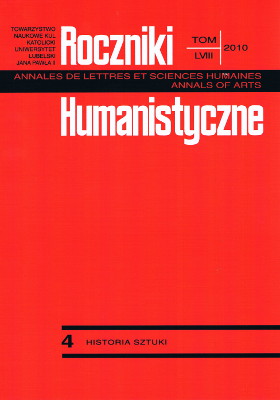Hagiographic Iconography Against the Background of Turkish Wars as Represented in the European Etching Graphics of the 16th to the 18th Century
Abstract
Engravers of the post-Tridentine period recorded the most important events of their time in their etching graphics. They created these works with a view to memorialise the events, but also in order to inform the public opinion about them and to influence their thinking. Hagiographic iconography was among the most frequent graphic themes of the time, which was owing to the atmosphere of the Tridentine reforms. The Council of Trent rediscovered art as a medium for communicating the religious message. The 16th and the 18th century witnessed an excessive confrontation between the European denominations, brutal religious wars and the Turkish invasion into Christian countries. Artistic accounts of the era display a lot of martial motifs, with noticeable emphasis on the endangered status of Christianity. Catholic Church directed human thinking towards God as an Almighty Power holding the world in His hands. The etching graphics that have survived until today testify to the prevalence of this message. The role of the Divine Providence was repeatedly highlighted, as was the mediation of the Mother of God and the Saints: they implored God to spare Christianity from the religious and military turmoil. The paper draws upon a vast selection of European etching graphics to present the power of the iconographic propaganda, with a special focus on the protective and supportive role of the Patron Saints.
References
Chapeaurouge D., Einführung in die Geschichte der christlichen Symbole, Darmstadt 1991.
Chrzanowski T., Działalność artystyczna Tomasza Tretera, Warszawa 1984. Czołowski A., Ikonografja wojenna Jana III, Warszawa 1930.
Die Zurückhaltung des Genres. Der Krieg in der Kunst der Republik, [w:] Krieg und Kultur. Die Rezeption von Krieg und Frieden in der Niederländischen Republik und im Deutschen Reich 1568-1648, hrsg. S. Groenveld, H. Lademacher, Münster u. a. 1998, s. 257-303.
Długosz J., Roczniki czyli Kroniki sławnego Królestwa polskiego. Ks. VII, Warszawa 1974.
Galavics G., Kössünk Kardot az pogàny ellen. Török hàborùk ès kèpzömüvèszet, Budapest 1986.
Gębarowicz M., Nowe materiały do ikonografii wojennej króla Jana III Sobieskiego, „Studia Wilanowskie” 3/4(1978), nr 3, s. 45-87.
Harms W., Rezeption des Mittelalters im Barock, [w:] Deutsche Barockliteratur und europäische Kultur. Zweites Jahrestreffen des Internationalen Arbeitskreises für deutsche Barockliteratur in der Herzog August Bibilothek Wolfenbüttel 28. bis 31. August 1976, Hamburg 1977, s. 23-52.
Hecht Ch., Katholische Bildertheologie im Zeitalter von Gegenreformation und Barock. Studien zu Traktaten von Johannes Molanus, Gabriele Paleotti und anderen Autoren, Berlin 1997.
Heinen U., Zur bildrhetorischen Wirkungsästhetik im Barock. Ein Systematisierungsversuch nach neurobiologischen Modellen, [w:] Bildrhetorik, hrsg. J. Knape, Baden−Baden 2007 (Saecvla Spiritalia 45), s. 113-158.
Hofmann W., Zauber der Medusa. Europäische Manieriesmen, hrsg. Wiener Festwochen, 3.4.-12.7.1987, Kat. IV.3.
Ikonografia batalistyczna w zagranicznych rezydencjach Marii Kazimiery Sobieskiej, „Studia Wilanowskie” 3/4(1978), s. 89-98.
Knapiński R., Witkowska A., Polskie niebo. Ikonografia hagiograficzna u progu XVII w., Pelplin 2007.
Knapiński R., Tak zwana kolońska seria druków „Icones et miracula Sanctorum Poloniae” wydana w oficynie Petera Overadta, „Barok” 27(2007), nr 1-2, s.1-21.
Knipping J., Iconography of the Counter Reformation in the Netherlands. Heaven on earth, vol. 2, Nieuwkoop–Leiden 1974.
Król Jan III Sobieski i jego epoka, oprac. J. Płocha, Warszawa 1986, s. 58-60.
Liber usualis. Missae et officii pro dominicis et festis cum cantu gregoriano ex Editione Vaticana adamussim excerpto, Parisis–Tornaci−Romae 1957.
Martin J. R., The Decoration for the Pompa Introitus Ferdinandi, Brüssel 1972 (Corpus Rubenianum 16).
Morka M., Tematyka batalistyczna w sztuce dworu Jana III, „Biuletyn Historii Sztuki” 53(1991), nr 1-2, s. 3-26.
Osiecka-Samsonowicz H., „Venimus, vidimus…” Kto zwyciężył? Rzymskie uroczystości na cześć wiktorii wiedeńskiej w 1683 r., [w:] Polska iEuropa w dobie nowożytnej. L’Europe moderne: nouveau monde, nouvelle Civilisation? Modern Europe – New Word, New Civilisation? Prace naukowe dedykowane Profesorowi Juliuszowi A. Chrościckiemu, Warszawa 2009, s. 47-54.
Ostrowski J., Flores vitae b. Salomeae, nieznany cykl graficzny Jerzego Eleutera Siemiginowskiego, „Biuletyn Historii Sztuki” 35(1973), nr 1, s. 43-52.
Semkowicz A., Krytyczny rozbiór Dziejów Polskich Jana Długosza (do roku 1384), Kraków 1887.
Szajnocha K., Szkice historyczne, t. I, Warszawa 1881.
Tomicka J., Triumf Kościoła i Ligi Świętej nad potęgą otomańską, 1686, [w:] Ars Mitologica. Wokół zagadnień recepcji mitów greckich. Ceramika i rzeźba starożytna. Grafika europejska oraz sztuka zdobnicza XVI-XIX wieku. Wystawa ze zbiorów Muzeum Narodowego w Warszawie, wrzesień-listopad 1999, Warszawa, poz. kat. 92.
Widacka H., Jan III Sobieski w grafice XVII i XVIII wieku, Warszawa 1987, s. 104, poz. kat. 93, il. 80.
Zodiacus Christianus. Jüdisch-christliche Adaptationen des Tierkreises von der Antike bis zur Gegenwart, hrsg. E. Heitsch, R. Merkelbach, C. Zinzen, Königsstein/Ts. 1983.
Copyright (c) 2010 Roczniki Humanistyczne

This work is licensed under a Creative Commons Attribution-NonCommercial-NoDerivatives 4.0 International License.





